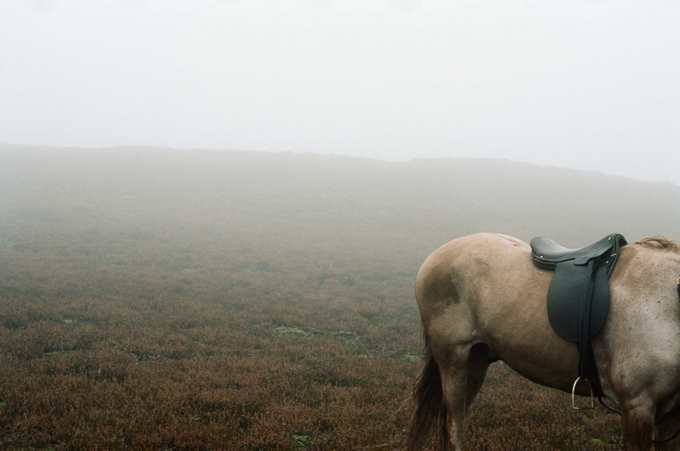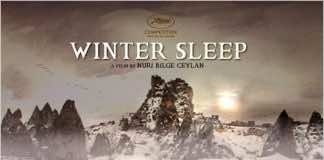I lingered round them, under that benign sky: watched the moths fluttering among the heath and harebells, listened to the soft wind breathing through the grass, and wondered how any one could ever imagine unquiet slumbers for the sleepers in that quiet earth.–Emily Brontë, Wuthering Heights
Anyone who knows the book Wuthering Heights knows of the atmosphere built up to the point that line appears in the novel. It’s hard to write about the latest cinematic adaptation of the book and not try to do the film justice in words without citing the source novel. British director Andrea Arnold captures the same atmosphere of that line in her film version. Raw and impressionistic, Arnold’s Wuthering Heights reaches beyond language and instead embraces the intimacy captured by the camera— focus, sound, light— to channel the feelings of the classic Victorian-era novel.
The feeling that this is not only a different type of adaptation of the book but a different kind of movie immediately becomes apparent in Arnold’s choice for the now rarely seen 1.33 : 1 aspect ratio.  The framing of the images only adds to the intimacy of a book often treated as an epic period piece in the many cinematic adaptations that have come before Arnold’s version. But that does not mean she short-changes on beautiful imagery rich with expression.
The framing of the images only adds to the intimacy of a book often treated as an epic period piece in the many cinematic adaptations that have come before Arnold’s version. But that does not mean she short-changes on beautiful imagery rich with expression.
Arnold plays with her depth of field focus to varied effect. Most often she keeps the focus so shallow the lens captures flakes of dust floating through the air with various sharpness, enhancing their depth in the air. There are moments when the camera catches the shadow inside the clavicle of one of the actors, emphasizing skin and bone and the fragility of humanity. When young Heathcliff (Solomon Glave, humble and sensitive) receives beatings there is both a sense of futility and empathy welled up in the action. The struggle between blurs and sharp focus only serve to emphasize the intimacy of the film. Young Catherine Earnshaw’s (Shannon Beer relishing playing the wild child) desperate but futile attempts to stop the beatings is as painful as it feels because of how close the film brings us to the actors despite the few words they exchange and the spare drama used to set up their relationship.
Arnold’s imagery, via her regular cinematographer Robbie Ryan, recalls the expressive quality of Wong Kar-Wai. The camera relishes textures like nothing ever committed to film.  When Catherine places a bridle over the head of a horse, the camera gives us a short glance of Catherine’s hand not only falling into the horse’s brown mane but also her thumb entering the beast’s ear. It’s a decision in action that makes the viewer consider texture on a deeper level, even though the camera lingers for only a brief, glancing second. The scene also emphasizes the importance of sound to capture atmosphere, from the horse’s snorts, to its subtle breathing, to its teeth on the bridle’s metal bit. The couple’s close connection is then established simply, as they share a ride on the back of the horse. Heathcliff smells her hair, which again taps into another sense to establish the film’s atmosphere. Watching the movie becomes an experience in synesthesia.
When Catherine places a bridle over the head of a horse, the camera gives us a short glance of Catherine’s hand not only falling into the horse’s brown mane but also her thumb entering the beast’s ear. It’s a decision in action that makes the viewer consider texture on a deeper level, even though the camera lingers for only a brief, glancing second. The scene also emphasizes the importance of sound to capture atmosphere, from the horse’s snorts, to its subtle breathing, to its teeth on the bridle’s metal bit. The couple’s close connection is then established simply, as they share a ride on the back of the horse. Heathcliff smells her hair, which again taps into another sense to establish the film’s atmosphere. Watching the movie becomes an experience in synesthesia.
Despite the intimacy of many of the scenes, Arnold does not leave out the landscape. Very early in the film, she captures the dank, dreary atmosphere of life on the Yorkshire moors, a landscape often enveloped in heavy cloud banks.  The wind is a powerful feature that howls over the slopes and in through the cracks of the farmhouse at the center of the film. The characters often slog and slip through mud to get to the front door of the house. Once inside, a twig taps on a windowpane, the wind still looking to possess the film. Murmured voices reading scripture also seep from one room to another, trying to penetrate these young heathens’ shared moments, but ghosts are little match for the heart beats of these two, which, at one point is felt through the bass of a theater’s sound system rather than heard: appropriate for a film about feelings over anything else.
The wind is a powerful feature that howls over the slopes and in through the cracks of the farmhouse at the center of the film. The characters often slog and slip through mud to get to the front door of the house. Once inside, a twig taps on a windowpane, the wind still looking to possess the film. Murmured voices reading scripture also seep from one room to another, trying to penetrate these young heathens’ shared moments, but ghosts are little match for the heart beats of these two, which, at one point is felt through the bass of a theater’s sound system rather than heard: appropriate for a film about feelings over anything else.
Arnold’s Wuthering Heights features a mostly drab and dark color palette.  But do not write the film off as simply wallowing in the dreary. Giant potions of bright whites often break up the imagery. There are also occasional splashes of dark versions of red, blue and green, which infuse scenes for an always exciting range that maintains a consistent, almost spectral atmosphere of a time long gone.
But do not write the film off as simply wallowing in the dreary. Giant potions of bright whites often break up the imagery. There are also occasional splashes of dark versions of red, blue and green, which infuse scenes for an always exciting range that maintains a consistent, almost spectral atmosphere of a time long gone.
Finally, Arnold also tempers the melodrama by skipping on a musical score. The brilliantly recorded sound of breath, wind, voices heard through walls and the all-bass, but barely audible heartbeat, offers more keen sonic ambiance than one can hope for with such a film. To top it off, the dialogue remains spare. When Cathy says “I am Heathcliff,” the words impregnate the film with so much more than a simple tale of love and revenge. This is man’s existential struggle made manifest by two primal beings.
So what about the story, you may ask. All these elements come together to create something beyond a story, actually.  The dynamic relationship between Cathy and a Heathcliff is there. The fact that the Heathcliff role is played by a black boy and later a black man (James Howson playing suppressed but dignified) might bother those seeking another traditional adaptation (what a dull notion). This casting in fact only highlights Heathcliff’s otherness in the Earnshaw household. When the boy is mistreated by Cathy’s older brother Hindley (Lee Shaw manifesting brooding menace) and Cathy can never do a thing, despite her attempts to fight back and scream, it only highlights the helpless state these two young people are in. Adding a further dose is how humans often treat animals. The animal-loving squeamish should be fairly warned: animal torture and death arises more than once in the film. However, it provides an important extension of the story’s primal quality.
The dynamic relationship between Cathy and a Heathcliff is there. The fact that the Heathcliff role is played by a black boy and later a black man (James Howson playing suppressed but dignified) might bother those seeking another traditional adaptation (what a dull notion). This casting in fact only highlights Heathcliff’s otherness in the Earnshaw household. When the boy is mistreated by Cathy’s older brother Hindley (Lee Shaw manifesting brooding menace) and Cathy can never do a thing, despite her attempts to fight back and scream, it only highlights the helpless state these two young people are in. Adding a further dose is how humans often treat animals. The animal-loving squeamish should be fairly warned: animal torture and death arises more than once in the film. However, it provides an important extension of the story’s primal quality.
The fact that Arnold put inexperienced actors in the major roles, besides older Cathy (minimally experienced, yet adequately ethereal Kaya Scodelario), adds to the film’s visceral quality.  They may not emote to the subtle effect one might yearn for in a piece like this, but Arnold makes up for that with all that she does on a cinematic level. I return to the spare dialogue and the fact that these are beings struggling to grow up while patriarchal figures bully them with righteous, dated notions in an attempt to mold their psyches. “I am Heathcliff” is about empathy for the other. God help us if people cannot relate with that at this point in society. This film is a must for anyone looking for some soul in cinema, a la Beasts of the Southern Wild and anti-James Bond.
They may not emote to the subtle effect one might yearn for in a piece like this, but Arnold makes up for that with all that she does on a cinematic level. I return to the spare dialogue and the fact that these are beings struggling to grow up while patriarchal figures bully them with righteous, dated notions in an attempt to mold their psyches. “I am Heathcliff” is about empathy for the other. God help us if people cannot relate with that at this point in society. This film is a must for anyone looking for some soul in cinema, a la Beasts of the Southern Wild and anti-James Bond.
trailer:
Wuthering Heights is not rated (mannered but intense with animal brutality) and runs 129 minutes. It is now playing in the South Florida area theatrically, at the Miami Beach Cinematheque in Miami Beach and the Cinema Paradiso in Fort Lauderdale. If you live outside of South Florida, it could very well be playing in your area now, but there are also other play dates planned nationally over the next few months. A full schedule can be found on the film’s official website, here. The Miami Beach Cinematheque invited me to a screening for the purposes of this review.











ooooooooooooooooh!!!!!!!
Interesting reaction to so many words (though expressive!!!)…. what do you think? Please share.